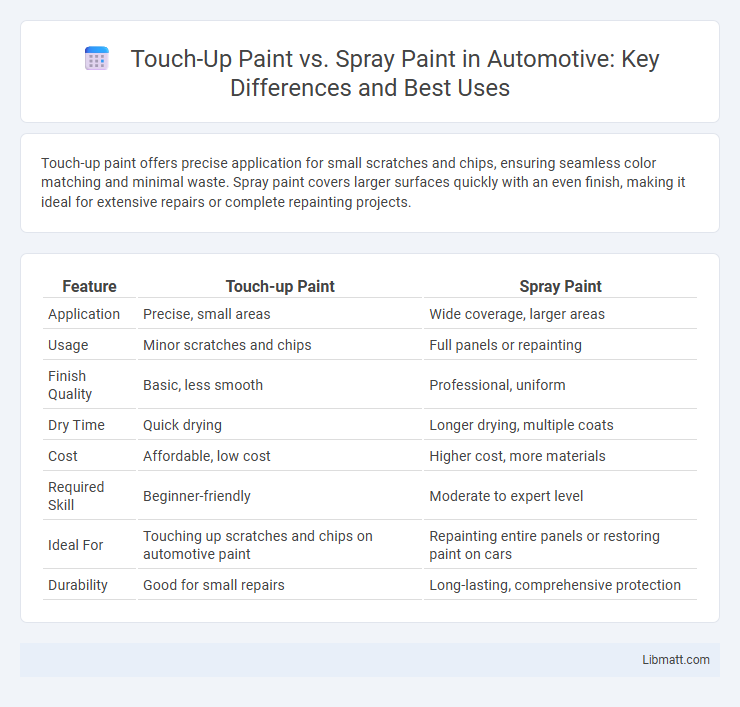Touch-up paint offers precise application for small scratches and chips, ensuring seamless color matching and minimal waste. Spray paint covers larger surfaces quickly with an even finish, making it ideal for extensive repairs or complete repainting projects.
Table of Comparison
| Feature | Touch-up Paint | Spray Paint |
|---|---|---|
| Application | Precise, small areas | Wide coverage, larger areas |
| Usage | Minor scratches and chips | Full panels or repainting |
| Finish Quality | Basic, less smooth | Professional, uniform |
| Dry Time | Quick drying | Longer drying, multiple coats |
| Cost | Affordable, low cost | Higher cost, more materials |
| Required Skill | Beginner-friendly | Moderate to expert level |
| Ideal For | Touching up scratches and chips on automotive paint | Repainting entire panels or restoring paint on cars |
| Durability | Good for small repairs | Long-lasting, comprehensive protection |
Introduction to Touch-Up Paint and Spray Paint
Touch-up paint is designed for small repairs and precise application, ideal for fixing minor scratches and chips on your vehicle's surface. Spray paint offers broader coverage and is suitable for larger areas requiring consistent, even coats, often used in repainting entire panels. Choosing between touch-up paint and spray paint depends on the size and detail of the repair needed for your car.
Key Differences Between Touch-Up Paint and Spray Paint
Touch-up paint is designed for small, precise repairs and typically comes in a pen or small bottle, allowing for accurate application to minor scratches or chips. Spray paint offers broader coverage with an aerosol can, ideal for repainting larger areas or entire panels for a more uniform finish. Understanding these key differences helps you select the right product for your repair needs, ensuring efficient and seamless results.
Surface Preparation Requirements
Touch-up paint requires minimal surface preparation, often needing just cleaning and light sanding to ensure adhesion, making it ideal for small repairs. Spray paint demands more thorough preparation, including extensive sanding, priming, and masking to achieve a smooth, even finish on larger surfaces. Your choice depends on the size and precision of the project, as proper preparation directly affects the durability and appearance of the paint.
Application Techniques Compared
Touch-up paint requires precise application typically with a small brush or pen to cover minor scratches and chips, offering better control and minimal paint waste. Spray paint applies evenly over larger surfaces using aerosol spray, ensuring smooth, consistent coverage but with a higher risk of overspray and uneven layers. Your choice depends on the size and detail of the repair area, with touch-up paint ideal for small fixes and spray paint suited for broader, uniform coatings.
Coverage and Finish Quality
Touch-up paint offers precise application with limited coverage, ideal for small scratches and chips, ensuring color matching with your vehicle's original finish. Spray paint provides broader coverage suitable for larger areas, delivering a smoother and more uniform finish but requires careful preparation and technique to avoid uneven layers or overspray. Choosing the right option depends on the size of the area needing repair and the desired level of finish quality for your project.
Durability and Longevity
Touch-up paint provides precise application for small repairs, but its durability is generally lower than spray paint due to uneven coverage and thinner layers. Spray paint offers a more uniform finish with stronger adhesion and longer-lasting protection against elements, making it ideal for larger surfaces. Your choice impacts the longevity of the repair, with spray paint ensuring a more resilient and lasting result.
Cost Considerations
Touch-up paint typically costs less than spray paint due to smaller quantities and targeted application, making it ideal for minor repairs and budget-conscious projects. Spray paint, while more expensive upfront, covers larger areas efficiently and may reduce labor costs for extensive repainting or refinishing. Your choice depends on the scale of the job and desired precision, impacting overall cost effectiveness.
Ideal Use Cases for Touch-Up Paint
Touch-up paint is ideal for small repairs such as scratches, chips, and minor dents on your vehicle's surface, providing precise coverage without affecting surrounding areas. It is best suited for localized color correction where spray paint may be excessive or cause overspray on adjacent panels. You can achieve a seamless finish by carefully applying touch-up paint to restore your car's original appearance in tight or detailed spots.
Best Situations for Spray Paint Use
Spray paint is ideal for covering large surfaces quickly and achieving a smooth, even finish, making it perfect for automotive bodywork, furniture, and outdoor projects. Its aerosol delivery system allows for consistent application on irregular surfaces and hard-to-reach areas, providing better coverage than touch-up paint. Spray paint is also preferred for color blending and refinishing tasks where uniformity and speed are crucial.
Choosing the Right Option for Your Project
Touch-up paint offers precise application for small scratches and chips, ensuring color matching and minimal mess, ideal for minor repairs on vehicles or furniture. Spray paint covers larger areas evenly, providing a smooth finish suitable for comprehensive projects or surface refinishing. Selecting the right option depends on project scale, surface type, and desired finish quality to achieve professional-looking results.
Touch-up paint vs Spray paint Infographic

 libmatt.com
libmatt.com